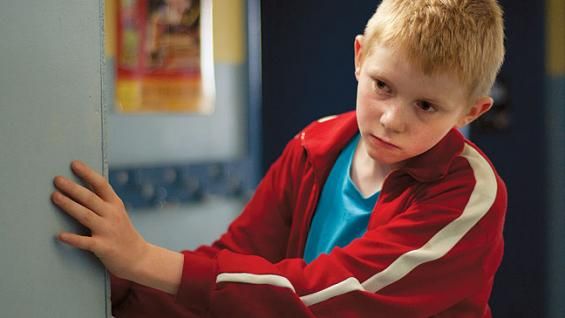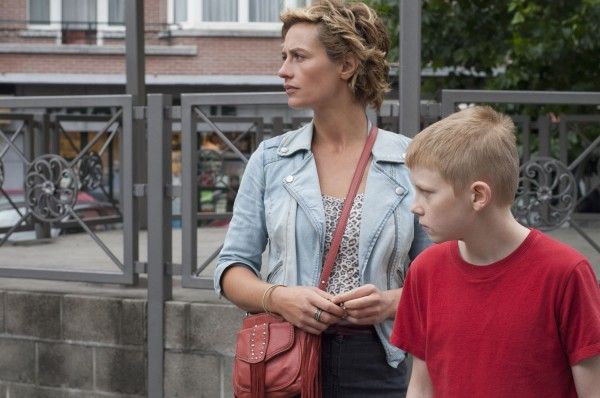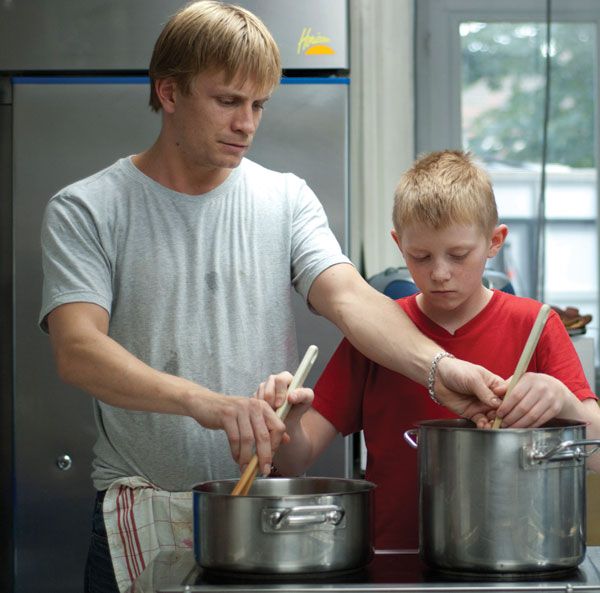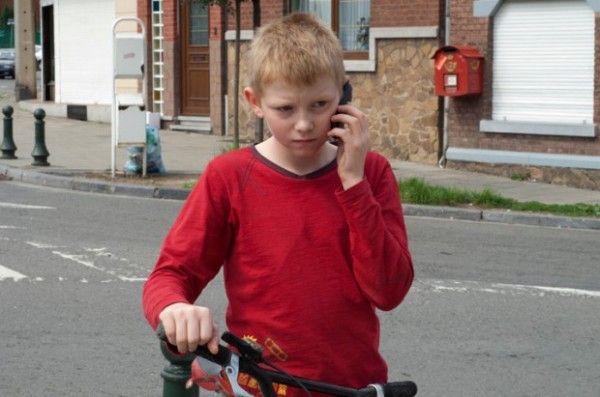Luc and Jean-Pierre Dardenne have created a body of work since 1996 which places them clearly at the forefront of contemporary Belgian cinema and among the world’s most critically respected filmmakers. Their deeply moving new film, The Kid with a Bike, which won the Grand Jury Prize at last year’s Cannes Film Festival, explores the emotional life of troubled 11-year-old Cyril (newcomer Thomas Doret) who is abandoned by his father (Jérémie Renier). His wild, unpredictable behavior and disastrous search for father figures almost costs him everything until a kind hairdresser (Cécile de France) befriends him and refuses to give up without a fight.
We sat down with the Dardenne Brothers at a roundtable interview to talk about The Kid with a Bike which was shot in the industrial town of Seraing in eastern Belgium where they grew up. The filmmaking duo explained why the theme of loneliness and abandonment in young people resonated with them, what happened during the audition process that convinced them Doret was perfect for the role of the young boy, and how the bike played a pivotal role in building the relationships between the different characters and advancing the storyline. They also explained why they feel this is ultimately a film that honors women. Continued after the jump.
Question: What was it about this story that appealed to you as filmmakers?
JEAN-PIERRE: Well, it was the bike which attracted us. We’re talking as filmmakers, right? It’s that when we thought about the boy, we immediately saw him on a bike. I think it’s because we saw him as very alone, very solitary, and the bike being his friend. When one is really alone, objects take on another type of importance. The bike was really where he released his violence and aggression. Initially, we saw him as using the bike to do all kinds of tricks and acrobatics and everything. But that’s where he really released a lot of that violent energy was onto the bike. We always need props to be able to start to think about a movie. And then, of course, the bike changed and evolved. There wasn’t always the violence that was there initially at the beginning that we had conceived of. For instance, when Samantha first brings back the bike, he performs these wheelies to impress her. Then, when the bike is stolen, he goes and gets it. The bike allowed us to build all the relationships between the different characters -- I mean, with Samantha, with Wes, with his father. For instance, when he goes to his father the last time, he jumps on the bike seat to get over the wall. We always tried to imagine the relationship of the bike in the scenes. In the long scene where he’s leaving his father and he’s pedaling to go towards Samantha, all that pedaling is also symbolic. It shows what’s going on in him, in his spirit and in his mind where he’s getting to the point of being able [to leave the past behind]. He’s leaving his father and he’s going towards Samantha and towards something new.
Where did you find Thomas Doret?
JEAN-PIERRE: We held an open casting call where we put ads on the radio and in the paper. We said we were looking for a child between 12 and 14, and then we got a certain number of responses, 600 responses. We culled them down to 150 and that’s how we did it.
How did you get that brilliant performance from a child that age? What is his background?
JEAN-PIERRE: He’s a boy. He goes to school. He’s a very good student. He was the fifth boy we saw on the first day of casting. For all of them, what we had them do as an audition was the first scene where he’s on the phone and we just said “Okay, you’re calling and you want your father to answer the phone. He’s not going to answer.” And that’s the direction we gave them.
LUC: One of us would play the role of the teacher who would say “Okay, c’mon, he’s not going to answer. Hang up.” So he had to convey two things through his acting: one, that he was waiting for somebody to pick up on the other end of the phone, and two, that he was bucking authority and struggling with an adult on the other end.
JEAN-PIERRE: When Tomas auditioned and we said “Action,” we really had the feeling that somebody was going to pick up on the other end of the phone. I don’t remember whether it was Luc or me that was playing the part of the teacher at that point, but when we said “Okay, now hang up” and we wanted to take the phone back, he really fought to keep that phone. But he didn’t do it with a lot [of physical aggression]. I mean, it was more like the way he looked at us. We thought there was so much intensity in that boy that we felt we were going to be able to work with him.
What was Cecile’s motive for becoming so involved with Cyril?
LUC: There is none. We didn’t want the audience to look at it as a psychological case that needs to be explained. It’s an excellent question but instead of saying that it was because she had dreamed of having a child or maybe she couldn’t have a child or maybe she had lost a child, we preferred to have the audience not see it as a psychological case and to maybe, ultimately, be thinking about those things.
JEAN-PIERRE: We wanted it to be a question mark throughout the whole movie where the audience isn’t really given an answer to it, but where there was some sort of answer through the behavior and through what happened in the film. So, in the final analysis, for the audience to say “I don’t know why she did it, but she did it.”
LUC: That’s why, in fact, we did the scene in the medical office where it’s shown through the physicality. The child grabs Samantha and she falls on the ground, but something very powerful happens between them which propels her towards the relationship, which propels the relationship, and one understands it through that.
How did you conceive of this character that Cecile played? Where did the idea of Samantha come from?
JEAN-PIERRE: It’s not one thing. It’s true that she did exist in another screenplay as a doctor that took care of children and there were several stages in the development of the story. I know that at some point she had become an older character, and we really didn’t want that for this particular story. I think she ended up being the synthesis of all our hesitations and wanderings, and at some point, it just gelled into the character that was realized in the film.
LUC: She’s the result of all the Samanthas that my brother and I said “Not that, not that, not that.”
You produced the greatest coup de foudre (love at first sight) in a film with this love that just happens in a touch.
LUC: There was that starting point where we wanted to tell the story about this boy who was abandoned by his father and who was saved by a woman. Samantha was never Sam.
JEAN-PIERRE: She’s a little bit of a father figure too, but she still continues to be called Samantha.
How does rehearsing your actors affect your filmmaking process and what was that experience like on this movie?
LUC: We’ve always rehearsed, but maybe not quite as much as this time.
JEAN-PIERRE: The rehearsals are really where the film is born because we work with very little camera. That’s also where we’re working within the sets, and we know where there are certain adjustments that are going to be made. We also know about it in terms of movement or action certain things that we’re now going to incorporate or work with.
LUC: When a rehearsal day is over, it’s wonderful because we can say everything is still possible because it’s all in movement. I mean, it’s correct. Those are the best moments. Everything is still possible. But, when you’ve started to shoot, after the first day, it’s not quite the same thing anymore.
JEAN-PIERRE: That’s where the actors start to live, and we start to feel that we find and discover things in terms of movements and attitudes and a variety of things.
LUC: We try different things but it does not come out of improvisation.
What is it about this theme of loneliness and abandonment in young people that emerges from this film and your earlier film, The Son, that resonates with you?
JEAN-PIERRE: In our personal history, there’s no link. We were not abandoned. But I think being abandoned is a nightmare that belongs to everybody. I think what was important was that the town, the city where we shoot our movies, Seraing, we saw it when it was alive, when there was a lot of intergenerational communication, when it was a living city. When we came back 20 years later, it had been abandoned. There was no longer a train station. All the stores were closed. And that’s when we saw young people starting to appear that were very alone. There was a lot of unemployment. A lot of parents were unemployed and there was no work for the kids. It’s like in our first film, The Promise, where you had a character that told the kid “You need to tell the truth and not do as your father does. You need to tell the truth. You’ve got to tell that person the truth.” We needed a moral compass for the film and for the character.
At the end of the film, when the boy takes off on his bike after he falls from the tree, I had the impression he was trying to leave his past behind.
JEAN-PIERRE: It’s like life wins. He picks up the bag of charcoal and he goes off to Samantha’s. It’s like life has won. It’s like Charlie Chaplin when he gives a little kick and he’s free and he can move forward.
LUC: He’s a free vagabond.
JEAN-PIERRE: But one never really leaves one’s past totally behind.
There’s an optimism that you see in your films.
JEAN-PIERRE: It’s fiction. (laughs)
The seduction of the child by the drug dealer is one of the most effective I’ve ever seen. Can you talk about the way you were able to strip away sentimentality so that it really is raw emotion?
LUC: We tried to show four different kinds of fathers in the film which are really bad fathers. There’s the one who abandons his child. There’s the seducer. There’s the jealous one, Samantha’s boyfriend. And then, there’s the liar at the end who says to his son, “We’ll say it’s not you.” It’s four men who are not able to be the father they should be -- one that doesn’t lie, one that doesn’t seduce, one that’s not jealous, and one that doesn’t abandon.
JEAN-PIERRE: It’s a film in honor of women.
LUC: And then, at the end of the day, we can say “Okay, it’s one woman who can be both a father and a mother.” Right now it’s a passage that we’re going through socially. There are a lot of women that are raising children alone.
The Kid with a Bike opens in NY and LA on March 16th.




